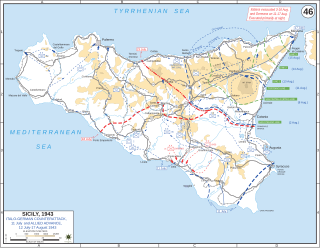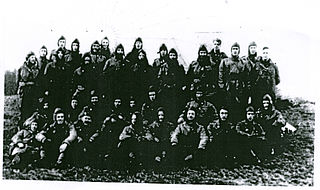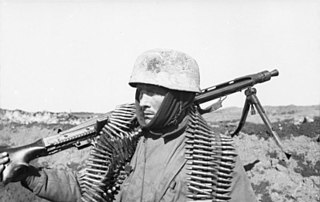
Operation Market Garden was an Allied military operation during the Second World War fought in the German-occupied Netherlands from 17 to 25 September 1944. Its objective was to create a 64 mi (103 km) salient into German territory with a bridgehead over the Nederrijn, creating an Allied invasion route into northern Germany. This was to be achieved by two sub-operations: seizing nine bridges with combined US and British airborne forces ("Market") followed by British land forces swiftly following over the bridges ("Garden").

Airborne forces are ground combat units carried by aircraft and airdropped into battle zones, typically by parachute drop. Parachute-qualified infantry and support personnel serving in airborne units are also known as paratroopers.

Operation Tonga was the codename given to the airborne operation undertaken by the British 6th Airborne Division between 5 June and 7 June 1944 as a part of Operation Overlord and the D-Day landings during the Second World War.

The Allied invasion of Sicily, also known as the Battle of Sicily and Operation Husky, was a major campaign of World War II in which the Allied forces invaded the island of Sicily in July 1943 and took it from the Axis powers. It began with a large amphibious and airborne operation, followed by a six-week land campaign, and initiated the Italian campaign.

Operation Ladbroke was a glider landing by British airborne troops during the Second World War near Syracuse, Sicily, that began on 9 July 1943 as part of Operation Husky, the Allied invasion of Sicily. The first Allied mission using large numbers of the aircraft, the operation was carried out from Tunisia by glider infantry of the British 1st Airlanding Brigade, commanded by Brigadier Philip Hicks, with a force of 136 Hadrians and eight Airspeed Horsas. The objective was to establish a large invasion force on the ground near the town of Syracuse, secure the Ponte Grande Bridge and ultimately take control of the city itself with its strategically vital docks, as a prelude to the full-scale invasion of Sicily.

Operation Fustian was an airborne forces operation undertaken during the Allied invasion of Sicily in July 1943 in the Second World War. The operation was carried out by Brigadier Gerald Lathbury's 1st Parachute Brigade, part of the British 1st Airborne Division. Their objective was the Primosole Bridge across the Simeto River. The intention was for the brigade, with glider-borne forces in support, to land on both sides of the river. They would then capture the bridge and secure the surrounding area until relieved by the advance of British XIII Corps, which had landed on the south eastern coast three days previously. Because the bridge was the only crossing on the river and would give the British Eighth Army access to the Catania plain, its capture was expected to speed the advance and lead to the defeat of the Axis forces in Sicily.

Operation Colossus was the codename given to the first airborne operation undertaken by the British military, which occurred on 10 February 1941 during World War II. The British airborne establishment was formed in June 1940 by the order of the British Prime Minister, Winston Churchill, in response to the successful airborne operations conducted by the German military during the Battle of France. Training began immediately but a shortage of proper equipment and training facilities, as well as bureaucratic difficulties, meant that only a small number of volunteers could immediately be trained as parachute troops. The first airborne unit to be formed was actually a re-trained Commando unit, No. 2 Commando, which was subsequently renamed as No. 11 Special Air Service Battalion and numbered approximately 350 officers and other ranks by September 1940. The battalion finished its training in December 1940 and in February 1941 thirty-eight members of the battalion, known as X Troop, were selected to conduct an airborne operation, which was intended to test the capability of the airborne troops and their equipment, as well as the ability of the Royal Air Force to accurately deliver them.

The 17th Airborne Division, "The Golden Talons", was an airborne infantry division of the United States Army during World War II, commanded by Major General William M. Miley.

Operation Varsity was a successful airborne forces operation launched by Allied troops toward the end of World War II. Involving more than 16,000 paratroopers and several thousand aircraft, it is the largest airborne operation ever conducted on a single day and in one location.

In military organizations, a pathfinder is a specialized soldier inserted or dropped into place in order to set up and operate drop zones, pickup zones, and helicopter landing sites for airborne operations, air resupply operations, or other air operations in support of the ground unit commander. Pathfinders first appeared in World War II, and continue to serve an important role in today's modern armed forces, providing commanders with the option of flexibly employing air assets. There was a group of pilots who were also designated pathfinders. They flew C-47 (DC-3) aircraft and were the lead planes followed by paratroop transports, used for dropping paratroopers into designate drop zones such as on D day, the Normandy Invasion.

Kurt Arthur Benno Student was a German general in the Luftwaffe during World War II. An early pioneer of airborne forces, Student was in overall command of developing a paratrooper force to be known as the Fallschirmjäger, and as the most senior member of the Fallschirmjäger, commanded it throughout the war. Student led the first major airborne attack in history, the Battle for The Hague, in May 1940. He also commanded the Fallschirmjäger in its last major airborne operation, the invasion of Crete in May 1941. The operation was a success despite German losses, and led the Allies to hasten the training and development of their own airborne units.
Colonel Edson Duncan Raff was a United States Army officer and writer of a book on paratroopers. He served as Commanding Officer (CO) of the first American paratroop unit to jump into combat, the 2nd Battalion, 509th Parachute Infantry Regiment, near Oran as part of Operation Torch during World War II. His book, We Jumped to Fight, was based on his experience in that operation and was published in 1944.

Current Commanders:

The Battle of Kos was a brief battle in World War II between British/Italian and German forces for control of the Greek island of Kos, in the then Italian-held Dodecanese Islands of the Aegean Sea. The battle was precipitated by the Allied Armistice with Italy. German forces with strong air support quickly overwhelmed the Italian garrison and the recent British reinforcements, denying the Allies a base to attack the German presence in the Balkans and leading to the expulsion and death of the island's Jewish population.

The 77th Air Refueling Squadron is a United States Air Force Reserve squadron, assigned to the 916th Operations Group, stationed at Seymour Johnson Air Force Base, North Carolina.

The British airborne operations in North Africa were conducted by British paratroopers of the 1st Parachute Brigade, commanded by Brigadier Edwin Flavell, as part of the Tunisian campaign of World War II, over the period between November 1942 and April 1943.

The Fallschirmjäger were the paratrooper branch of the German Luftwaffe before and during World War II. They were the first paratroopers to be committed in large-scale airborne operations. Throughout World War II, the commander of the branch was Kurt Student, as he was the 2nd most senior officer in the Luftwaffe.

The Battle of Heraklion was part of the Battle of Crete, fought during World War II on the Greek island of Crete between 20 and 30 May 1941. British, Australian and Greek forces of 14th Infantry Brigade, commanded by Brigadier Brian Chappel, defended Heraklion port and airfield against a German paratrooper attack by the 1st Parachute Regiment of the 7th Air Division, commanded by Colonel Bruno Bräuer.

The 185th Paratroopers Reconnaissance Target Acquisition Regiment "Folgore" is an Italian Army special forces unit. The regiment is part of the Italian Army's infantry arm's Paracadutisti speciality and assigned to the Army Special Forces Command.

The 183rd Paratroopers Regiment "Nembo" is an active unit of the Italian Army based in Pistoia in Tuscany. The regiment is part of the Italian Army's infantry arm's Paracadutisti speciality and assigned to the Paratroopers Brigade "Folgore".
William Fowler (2010): The Secret War in Italy; Operation Herring and No 1 Italian SAS, Ian Allan, ISBN 9780711035287





















